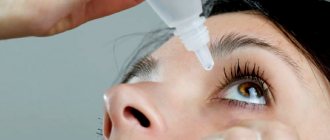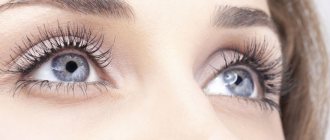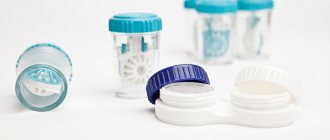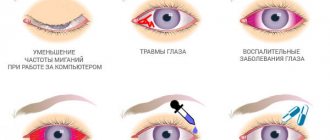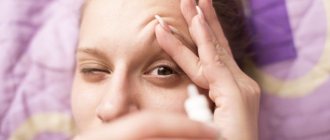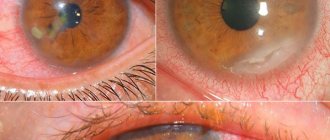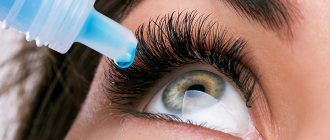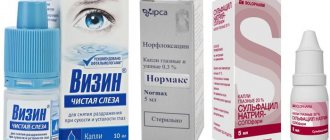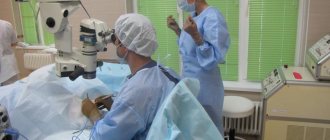Eye fatigue: how to determine if you have it
Scientists call eye fatigue the term asthenopia. It means rapid fatigue of the visual organs during visual work, especially if it occurs at close range.
This is not a disease, however, if asthenopia is not treated, it can cause refractive errors and significant eye ailments. Therefore, experts advise not to ignore the first symptoms of visual fatigue. The following signs will help determine whether you have asthenopia:
- Blurred vision, it seems as if there is a “veil” before the eyes;
- Blurry picture;
- Distortion of the perception of the shapes of objects; it seems to a person that they are larger or smaller than their actual dimensions;
- Often the eyes may be red and appear inflamed;
- Temperature may rise in the area of the visual organs;
- Watery eyes may often occur;
- A person is overcome by a feeling of discomfort, he feels pain and pain.
In addition, asthenopia may cause headaches and increased irritability.
What is a spasm of accommodation?
Accommodation is the ability of the eye to focus well, both on distant objects and on those that are close. For the most part, the ciliary muscle is responsible for focus. When there is prolonged tension, the ciliary muscle gets tired, therefore, it becomes difficult to focus. A spasm of accommodation occurs, that is, overwork, as a result of which a person has difficulty seeing into the distance. This process is reversible, which is why the accommodation spasm is called false myopia. But if a person with a spasm of accommodation postpones a visit to the ophthalmologist for a long time, then false myopia will become real and myopia will develop.
What causes your eyes to get tired?
The visual organs get most tired in people who spend a lot of time looking at a computer screen, doing handicrafts, or reading. To focus their gaze at a close distance, these people must strain their eye muscles for a long time. Due to overstrain, the facial and eye muscles begin to contract, which causes pain. In addition, the person begins to blink not as often as necessary, so the mucous membrane dries out, signs of irritation appear, itching and redness occur. Most often, people suffering from refractive errors such as astigmatism, myopia and others experience eye fatigue.
Also, asthenopia can be provoked by inflammatory diseases of the organs of vision, osteochondrosis, surges in intraocular pressure, the use of incorrectly selected ophthalmic agents, hormonal imbalance and too dry air in the room. In some cases, eye fatigue can be caused by taking certain medications that negatively affect the formation of the tear film.
Whatever the cause of asthenopia, it should not be neglected and must be treated. Anti-fatigue eye drops are effective medications used in the treatment of this condition.
Features and benefits of eye antiseptics
Antiseptic eye drops can be used for infectious diseases of a bacterial, viral or fungal nature, as well as for the prevention of postoperative complications. Eye antiseptics help stop or prevent the growth and reproduction of pathogenic microorganisms, accelerate the tissue healing process, and can shorten the rehabilitation period. Essentially, antiseptic eye drops perform a disinfecting function. As a rule, they have a wide spectrum of action, so they destroy different types of pathogens. Antiseptics are effective in combating resistant strains of bacteria that are difficult to treat with antibiotics. It is also advisable to use them as early as possible from the onset of an acute infectious process. To prescribe antibacterial agents, you must first conduct tests to select the right drug, but this takes time. Antiseptic drops in such a situation are often the best solution. They relieve redness, stop the proliferation of viruses and bacteria, and help quickly alleviate the patient’s condition with uveitis, conjunctivitis and other inflammatory diseases.
Another advantage of eye antiseptics over antibiotics is that the former practically do not cause allergies and do not have a systemic effect on the human body, while the latter often give allergic-toxic reactions and other side effects.
Types of drops for visual fatigue
Asthenopia appears for various reasons and is accompanied by different symptoms, so without consulting a specialist it is impossible to prescribe universal eye drops for fatigue that would be equally good for all patients. Before proceeding with treatment, you should consult with an experienced doctor. He will carefully examine the eyes, identify the reason why they get tired and, if necessary, prescribe a remedy from one of the following categories:
- drops with a moisturizing effect. They renew the eye film and shape it, prevent irritation and dryness of the organs of vision, and protect against unwanted environmental influences. Special moisturizing solutions have been developed for people who use contact lenses. They are prescribed to further moisturize the cornea;
- means that eliminate fatigue when working on a PC. These medications contain vitamin supplements. Drops not only moisturize the mucous membrane, but also preserve clarity of vision during prolonged sitting at the monitor and act as a prophylactic against “dry eye syndrome”;
- solutions with a vasoconstrictor effect. They eliminate puffiness and normalize the activity of the eye vessels in case of visual strain. Individual drops act as a local anesthetic.
Without examination by a specialist, it is allowed to use only artificial tear substitutes that normalize the level of moisture in the eyes. In other cases, the drops must be prescribed by an ophthalmologist. And children are not allowed to put any solution in their eyes at all.
Vitamin drops for cataracts
Elderly patients, regardless of their vision condition, can use vitamin drops to support the organs of the optical system, restore their functionality, and also improve their overall well-being.
Special drops for elderly patients are usually combined (Taufon, Quinax, Katahrom, Vitofakol, Vita-iodurol) most often aimed at slowing down the process of clouding of the lens (cataract development). These complexes contain vitamins B and C, amino acids, and various antioxidants.
When using such drops, metabolic processes are activated and the natural aging of the lens is slowed down. If, in addition to instilling eye drops, you enrich your diet with foods high in vitamins E and C and omega-3 fatty acids, then the effectiveness of prevention and treatment will increase. In addition, the use of vitamin drops is suitable for patients with chronic ophthalmological diseases (for example, glaucoma) and eyeball trauma.
If you regularly take tablets or capsules with vitamins and minerals, as well as instill such drops into your eyes, you can restore vision even in old age, slow down the aging process and improve performance.
Budget options for eye drops that relieve fatigue when working at a computer
Users who spend a long time in front of a computer monitor use products that relieve visual fatigue, both for therapeutic and preventive purposes. Not everyone can afford to buy expensive drops, so they prefer cheaper products.
Each person interprets the concepts of “expensive” and “cheap” in his own way. It all depends on the financial capabilities of the patients. Therefore, we can only conditionally divide drops that relieve eye fatigue into expensive and inexpensive:
- “Vizin” is a drug that relieves swelling, eliminates redness and the feeling of irritation of the organs of vision when working at a computer. Drops make the surface of the eyes moisturized and act as a vasoconstrictor. It is recommended to instill eye drops with this remedy every four hours;
- “Artelak” is a product that perfectly relieves fatigue from the eyes and helps with their dryness. The drug exhibits a restorative and moisturizing effect, restores the fat layer and normalizes the composition of the tear film. By regularly instilling these drops into the organs of vision, a person will feel their positive effect within a few days: fatigue will disappear without a trace, and the quality of the tear film will become much better. The drug has a high level of viscosity, due to which it can remain on the surface of the eye for more time, guaranteeing a therapeutic effect.
People whose eyes are overly sensitive should give preference to Hilo-chest drops. They cannot be called very cheap, however, they have a mild effect.
Inexpensive drops when wearing contact ophthalmology
People who use the highest quality contact lenses often suffer from eye fatigue. Moisturizing drops combined with lenses will easily solve this problem. Among the inexpensive options you can pay attention to:
- "Systane Ultra" They are suitable for users wearing soft contact optics. The product moisturizes and lubricates the surface of the lenses, making wearing them much more comfortable. You can instill the solution into your eyes if you sit in front of the monitor for a long time: it will act like an artificial tear;
- Ophthalmix Bio Fresh Eye. These drops are considered relatively inexpensive. If you wear lenses, the solution will perfectly moisturize your vision and eliminate fatigue. It can be used not only when working with a screen, but also when staying in a room for a long time where dry air predominates;
- Adria Relax. The drug is made in South Korea, it eliminates tension from the eyeballs and makes the surface of the lenses moisturized. The drops contain sodium hyaluronate and succinic acid, which is an antioxidant and protects the retina from harmful effects.
We have described only some types of drops that can help get rid of eye fatigue. In reality, the choice of such drugs is huge. A patient with any financial capabilities will be able to choose an option that suits his budget.
Symptoms of spasm of accommodation
Below we list the symptoms that accompany spasm of accommodation of the eye. If you observe any of these in yourself, make an appointment with an ophthalmologist. As mentioned above, the spasm itself is not dangerous, but constant tension in the eyes can provoke the development of real, rather than false, myopia, the causes of which will be much more difficult to eliminate. How to understand that you have a spasm of accommodation? Most likely, you are experiencing the following symptoms:
- You get tired quickly, especially when working with small objects;
- there are redness, pain in the eyes, as well as pain and burning;
- nearby objects become less clear, and objects in the distance take on a blurry and bifurcated shape;
- the child’s performance decreases and he quickly gets tired in class;
- Headaches are common.
Sometimes a spasm of eye accommodation is accompanied by hand tremors, increased irritability, and in some cases fainting. According to statistics, every sixth schoolchild suffers from false myopia due to incorrect posture, uncomfortable furniture for studying, poor lighting and the rather long time he spends playing games in front of the computer. False myopia lasts from two months to several years.
How to prevent eye fatigue?
If you do not fight the cause of eye fatigue, then even the most expensive drops from a world-famous manufacturer will only have a short-term effect. By adhering to preventive measures, you can increase the effectiveness of ophthalmic products:
- do not use lenses longer than the period for which they are prescribed;
- When working at a computer, take a break every hour;
- try to blink as often as possible, take your eyes away from the screen for a few seconds to peer into the distance;
- to relieve tension from the organs of vision, do simple gymnastic exercises for the eyes and massage;
- maintain the brightness of the lighting and the distance from your eyes to the monitor;
- See an ophthalmologist every six months. This must be done even when nothing is bothering you.
Many modern users experience eye fatigue. This is not a disease, however, such a condition can cause visual impairment. To avoid this, you need to go to the doctor at the first “hints” of asthenopia. The ophthalmologist will prescribe the appropriate medication and prescribe other treatment options to get rid of the ailment.
In what cases are Okomistin drops used?
This antiseptic is often prescribed for injuries to the visual organs, inflammation of the cornea, choroid, blepharoconjunctivitis, chronic and acute conjunctivitis and other diseases and conditions in which an inflammatory process develops in the eyes. The drug is also prescribed to prevent complications after eye surgery. A prophylactic course is prescribed a couple of days before surgery.
In fact, “Okomistin” is an ophthalmological analogue of the well-known antiseptic “Miramistin”, which is used in other medical fields (gynecology, otolaryngology, surgery). "Okomistin" acts in several directions at once:
- it destroys the cellular structure of bacteria, including resistant ones (that is, resistant to antibacterial drugs);
- effectively fights certain types of viruses and fungal pathogens;
- increases local immunity, reduces the severity of the inflammatory process.
Also, antiseptic drops make bacteria more sensitive to antibiotics and for this reason are often used in the complex treatment of eye diseases.
